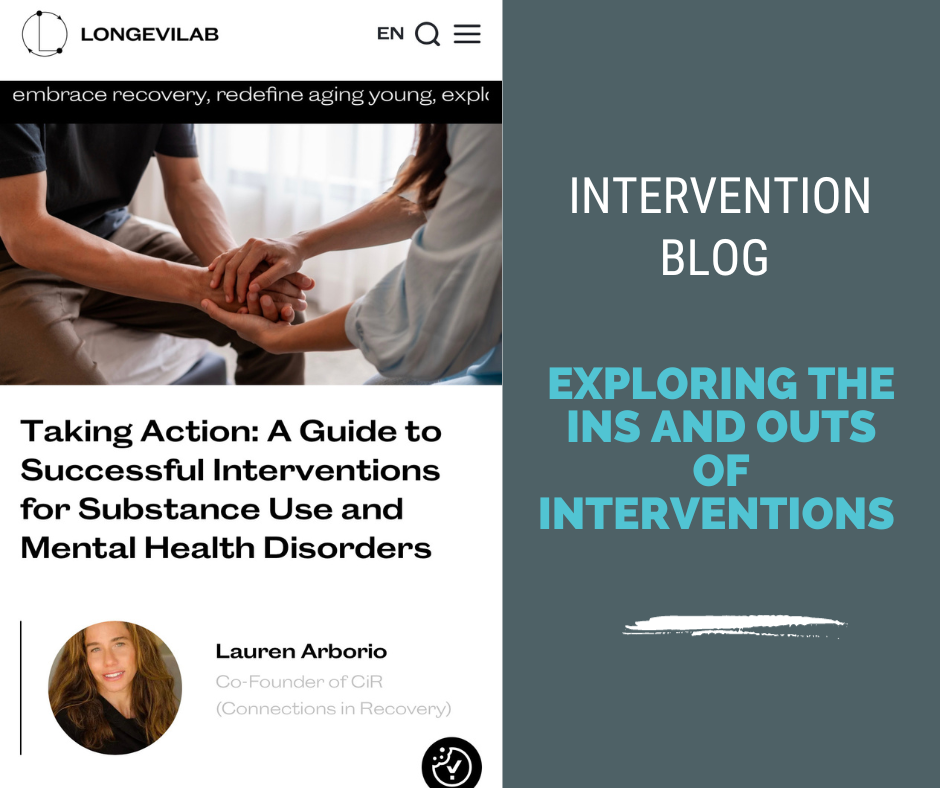Original Blog hosted by our friends at Longevilab/Blog author: Lauren Arborio, Co-Founder of CiR (Connections in Recovery)
Supporting Your Loved One on the Road to Recovery
Watching a loved one grapple with substance misuse or mental health disorders is undoubtedly challenging. Despite our best efforts to communicate our concerns, some individuals may remain in denial or unwilling to seek help. In such cases, a formal intervention can be a powerful and compassionate approach to guide them toward the path of recovery. In this blog, we’ll explore the ins and outs of interventions, focusing on their significance and providing a step-by-step guide to help you and your loved ones navigate this delicate process.
Understanding the Need for Intervention
Substance misuse and mental health disorders can manifest in various forms, including alcoholism, prescription drug abuse, eating disorders, and more. Individuals struggling with these issues often fail to recognize the impact of their behaviors on themselves and those around them. The purpose of an intervention is to create a structured opportunity for your loved one to acknowledge the problem and take steps toward seeking or accepting help.

Photo / Longevilab
What is an Intervention?
An intervention is a carefully orchestrated process involving family, friends, and sometimes professionals. It serves as a platform to confront the individual with the substance use or mental health disorder, presenting specific examples of destructive behaviors and their consequences. The intervention also outlines a prearranged treatment plan with clear steps and goals.
Steps of a Typical Intervention:
- Make a Plan:
- Propose the intervention and form a planning group.
- Consult with professionals for guidance and support.
- Choose a Treatment Program:
- Research and select a treatment facility that aligns with your loved one’s needs.
- Gather Information:
- Learn about the extent of the problem and research treatment programs.
- Form the Intervention Team:
- Assemble a team that will participate in the intervention.
- Set a date, location, and create a rehearsed, consistent message.
- Decide on Specific Consequences:
- Determine actions if your loved one refuses treatment.
- Make Notes on What to Say:
- Share specific incidents, expressing care and the expectation of change.
- Hold the Intervention Meeting:
- Ask your loved one to the site without revealing the reason.
- Express concerns, present a treatment option, and request immediate acceptance.
- Follow Up:
- Involve family and others to support ongoing treatment.
- Change patterns to avoid destructive behavior and seek your own support.
- Case Management:
- Seek professional assistance in choosing a treatment facility.
- Receive ongoing case management support, including discharge planning.
Beyond the Intervention: Navigating the Journey of Recovery – What Can Our Loved One in Treatment Expect Now?
Embarking on the path of recovery is a courageous step for individuals confronting substance use or mental health disorders. Yet, the journey doesn’t end with the intervention; it’s a continuous process that requires ongoing support, guidance, and planning.
An interventionist serves as a vital link between families and treatment centers, offering assistance in the selection of the right facility for your loved one. But their involvement doesn’t conclude there; instead, they commit to working closely with families for an extended period, often up to a year after the intervention.
In the post-intervention phase, your interventionist becomes an invaluable resource, providing education and support to family members. This ongoing relationship ensures regular communication with the clinical staff at the treatment center, evaluates the effectiveness of the chosen facility, and facilitates any necessary transitions to more suitable locations if needed.
The interventionist’s role extends beyond the individual in treatment; they play a crucial part in the care and well-being of the entire family. By helping design treatment plans for each family member, guiding patients and families to reputable local counselors, and facilitating aftercare once the initial treatment is completed, they ensure a comprehensive and holistic approach to recovery.
Moreover, the interventionist assists with transitions and reintegration issues when your loved one returns home, acknowledging that the journey continues even after leaving the treatment facility. If challenges arise, including the possibility of relapse, the interventionist remains a steadfast support system, helping families navigate the process once again.
Conclusion
A well-executed intervention is a lifeline for those struggling with substance use or mental health disorders. By approaching the situation with care, understanding, and a clear plan, you can increase the likelihood of your loved one accepting the help they need. Remember, successful interventions require thoughtful preparation and ongoing support, so don’t hesitate to seek professional guidance throughout the process.

If you know someone who needs an intervention, rest assured that together we will find the right treatment for your client or loved one. Visit us for more information: www.ConnectionsInRecovery.com


